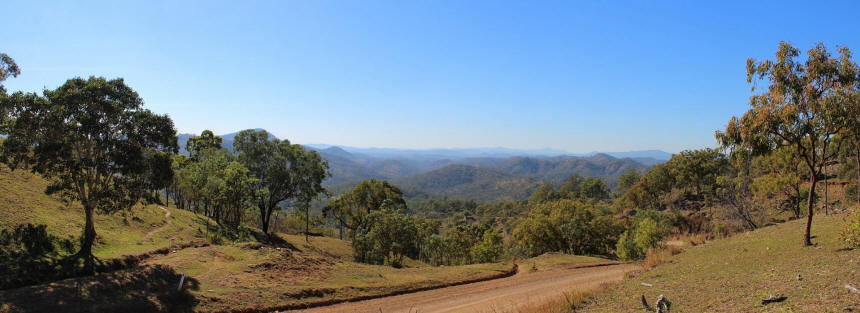|



Looking back from the Tops towards
Calliope
Kroombit Tops in Central Queensland had been on
our bucket list of locations to explore for a number of years & as
it happened last June 2017 presented a window of opportunity. There
are no facilities in Kroombit Tops National Park, so you need to go
totally self sufficient. We travelled up the steep well formed
gravel road from Calliope on Tableland Road through farmland. After
the climb we were treated to magnificent views of the surrounding
valleys & gorges below, dominated by sandstone cliffs up to
one-hundred metres high.
Kroombit Tops Plateau is nine-hundred metres in altitude & protected
within the Kroombit Tops National Park. The plateau receives around
1800mm of rainfall a year, the location of which depends on a number
of factors including elevation & aspect. There are more than
eight-hundred & fifty plant species, three of which are only found
on the plateau while many more are listed as rare or threatend.
In the wetter south-eastern sandstone country,
blackbutt forests dominate, while subtropical rainforests grow
around Three Moon & Munholme creeks. Piccabeen palms, brush box,
coachwood & white beech, which are normally found further south in
temperate rainforests, can be found here.
On the parks eastern slopes & broad valley floors, open Sydney blue
gum forests, pink bloodwood and rough-barked apple trees flourish.
Sydney blue gum is another southern species normally found along the
coast from south-east Queensland to Batemans Bay in southern New
South Wales. It was one of the main trees harvested at Kroombit Tops
from 1969 to 1995.
Further west the vegetation changes to drier white mahogany, grey
gum & ironbark woodlands. In rocky areas, a stunted form of brush
box locally known as 'supplejack' grows. This thin whip-like variety
of brush box is very different from the towering subtropical
rainforest form.
Dry rainforest grows in fire-resistant gullies on the drier western
slopes with hoop pines towering above the canopy. Some individuals
can grow as tall as forty to fifty metres. In the far west, hoop
pine forests merge with a dry bottle tree community.
The varied vegetation & topography of Kroombit
Tops shelters diverse wildlife with 71 mammal species, 165 bird
species, 70 reptile species, 30 amphibians & numerous insect &
spider species. One frog, the Kroombit tinkerfrog is found nowhere
else.
After stopping for morning tea just off the road away from the dust,
although we had not seen another vehicle all morning, we drove into
the Razorback camping area for a look. There are no trailers allowed
on the trail past the camping area towards Biloela.
Continuing on Tableland Road we veered off onto the two-way section
of the loop road to visit the crash site of ‘Beautiful Betsy’, a B24
Liberator bomber. The plane went missing on 26th February 1945 while
flying between Fenton Airfield in the Northern Territory to Eagle
Farm in Brisbane with the loss of eight lives. It wasn’t until
forty-nine years later on 2nd August 1994 when park ranger, Mark
Roe, was checking the results of a controlled burn-off when he saw
something glinting in the sunlight it was eventually found.
We then headed down the steep one-way 4wd track to the Wall camping
area. Next morning there was more 4wding as we drove towards
Griffiths Creek camping area where we set up for a couple of days to
wander in the bush on foot & observing the many species birds.
It was time to pack up once again & head south towards Cania,
stopping at the Escarpment Lookout for views over the Boyne Valley &
also to take the loop walk in the rainforest. The road then narrowed
to a track as it drops off the tops with a few step descents. Carol
was kept busy opening a number of farm gates as we travelled through
properties. One double farm gate proved to be a problem for Carol as
they both swung away. It was funny watching her swinging one gate up
& running for the other, trying to catch both in the middle to latch
the chain. |

